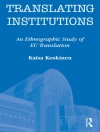This book evaluates the origins of processes of change in language teaching in China, and the factors influencing their success. Examining diverse experiences and drawing on the perspectives of academics from the top institutions in the country, the authors analyse the complex interplay between global and local influences on language policies. Encouraging discussion of the significant education reforms that have taken place in China in recent years, this work will be of interest to students and scholars of language education, English as a Second Language and applied linguistics.
विषयसूची
– Chapter 1. Innovation in China: An Overview; David Nunan, Hayo Reinders, Bin Zou.- Chapter 2. Assessment for learning in English Language Classrooms in China: Contexts, Problems, and Solutions; Jun Liu, Yueting Xu.- Chapter 3. Learning to Speak in an Exam-Focused World: A Study of Independent Language Learning in China; Don Snow, Olivia Sun, Xu Li.- Chapter 4. Innovations in writing instruction in China: Metasynthesis of qualitative research for the period 2005-2016; Chiew Hong Ng and Yin Ling Cheung.- Chapter 5. Technology-Enhanced Content and Language Integrated Learning in Chinese Tertiary English Classes: Potentials and Challenges; Ke Zhao, Chunlin Lei.- Chapter 6. Debates around the paradigm shift in the development of TEFL in Chinese tertiary institutions; Jigang Cai.- Chapter 7. From EAP Teaching to English-Medium Instruction: Innovation in EFL Curriculum at Tsinghua University in China; Weimin Zhang, Hao Zhang.- Chapter 8. ESP/EAP through English-Medium Instruction: Teachers’Perceptions and Practices; Li Jiang, Lawrence Jun Zhang.- Chapter 9. Students’ perceptions and practices in L2 disciplinary writing at an English medium university in mainland China; Zhoulin Ruan, Jinhua Chen.- Chapter 10. The implementation of EAP instruction in a local university in China; Beibei Zhao, Guoxing Yu.- Chapter 11. Using Corpora to Investigate Chinese University EFL Learners; Bin Zou, Hayo Reinders.- Chapter 12. Facilitating transformative learning towards productive bilingualism: Innovations in teaching English for intercultural communication in China; Xuan Zheng, Yihong Gao.- Chapter 13. Contemporary Research in Intercultural Teaching in China: A Critical Review; Citing Li.- Chapter 14. Assessing Learning Autonomy: Development and validation of a localised scale; Lilian Lin, Hayo Reinders.
लेखक के बारे में
Hayo Reinders is Professor of Education and Head of Department at Unitec, New Zealand, and Dean of the Graduate School at Anaheim University, USA. His research interests include educational technology, learner autonomy, and out-of-class learning, and he has published over 20 books. He is the editor of the ‘New Language Learning and Teaching Environments’ series for Palgrave Macmillan.
David Nunan is Chair of the Research Committee, Director of the MA TESOL Program and Director of the David Nunan Institute for Language Education at Anaheim University, USA. He is also Professor Emeritus at the University of Hong Kong, China. He has published over 100 books and articles in the areas of curriculum and materials development, classroom-based research and discourse analysis.
Bin Zou is Senior Tutor / Associate Professor at the Language Centre, Xi’an Jioatong Liverpool University, China. His research interests include English Language Teaching, Computer Assisted Language Learning and English for Academic Purposes. He is an executive committee member of the China English for Academic Purposes Association and an executive committee member of the China Computer-Assisted Language Learning Association.












